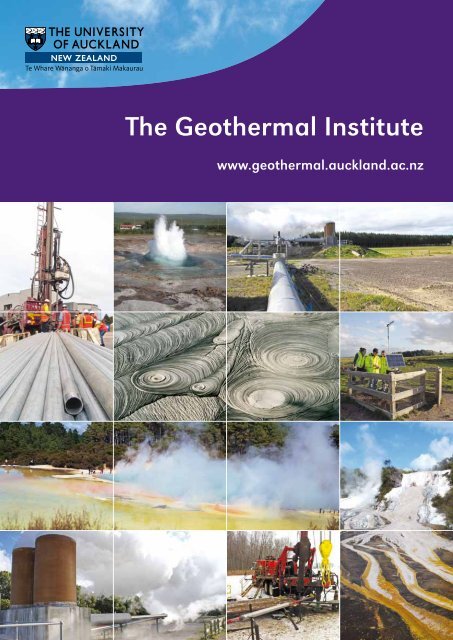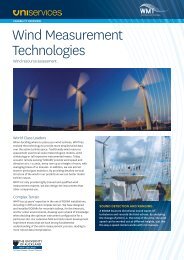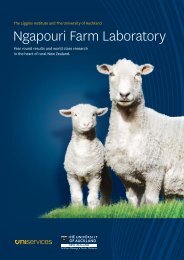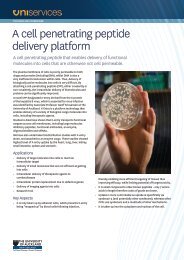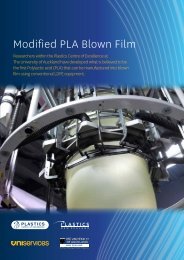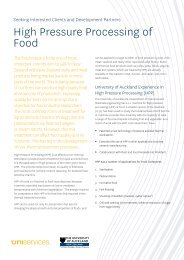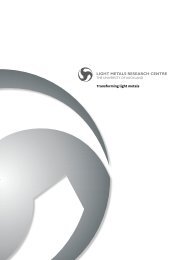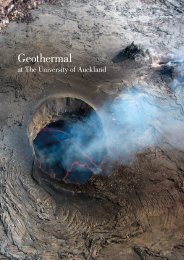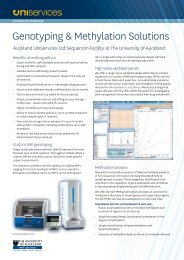The Geothermal Institute brochure - UniServices
The Geothermal Institute brochure - UniServices
The Geothermal Institute brochure - UniServices
You also want an ePaper? Increase the reach of your titles
YUMPU automatically turns print PDFs into web optimized ePapers that Google loves.
<strong>The</strong> <strong>Geothermal</strong> <strong>Institute</strong>www.geothermal.auckland.ac.nz
<strong>The</strong> University of Auckland<strong>The</strong> University of Auckland is New Zealand’s leading and largest university. It isranked in the top 100 of the QS World University Rankings and is the highestranked New Zealand University in the Times Higher Education and Shanghai JiaoTong Academic Ranking of World Universities. <strong>The</strong> University of Auckland is aninternational centre of learning and academic excellence. It is New Zealand’spre-eminent research-led institution and has key linkages with many of the world’stop research intensive universities.Based in the heart of New Zealand’s largest and most diverse city, <strong>The</strong> University ofAuckland has the most comprehensive range of courses in the country. <strong>The</strong>University’s mission is to be a research-led, international university, recognised forexcellence in teaching, learning, research, creative work and administration.In a snapshot <strong>The</strong> University of Auckland:• Comprehensive University with full range of professional schools to PhD level• 41,000 students and 5,400 staff including 4,700 international students fromover 100 countries• 2,750 academic staff in eight Faculties• About 10,700 postgraduate students including 2,100 at doctoral level• More than 60 research units, centres and institutes• More than 6,500 research articles, books and conference papers publishedannually• 200 active patent families and about 630 granted patents or pending patentapplications globally.• External research funding of NZ$218 million pa in 2010.<strong>The</strong> University actively seeks to work with government, energy companies, otheruniversities, research organisations and commercial consultancies in geothermalresearch, development and education.<strong>Geothermal</strong> New ZealandBuilding on more than 60 years’ experience in identifying and utilising its owngeothermal resources, New Zealand has significant expertise in the developmentand sustainable management of geothermal fields and in the design, construction,operation and maintenance of geothermal power plants. New Zealand has morethan 25 high temperature geothermal systems and with many beautiful naturalgeothermal springs. <strong>The</strong> Wairakei geothermal system was the first liquid-dominatedhigh temperature geothermal system to be developed for power generation in1958, and since then New Zealand has been at the forefront of geothermalresearch and training. New Zealand has also built up an excellent reputation in theapplication of geothermal energy for direct use in Industry.<strong>Geothermal</strong> New Zealand brings many strengths to the international geothermalsector:• New Zealand was a pioneer in geothermal generation in the 1950s and has anoutstanding reputation for its geothermal expertise around the world.• Domestic geothermal capacity is now some 750MW, over 12% of the electricitygenerated in New Zealand, and will soon reach 1,000MW placing the countryamongst the largest geothermal power producers globally.• New Zealand scientific and engineering skills have contributed to over 1,000MW of geothermal power developments internationally and the identification offar greater potential resources.• New Zealand has built a number of new domestic plants in recent years; theseare recognised as representing world’s best practices from the application ofexploration sciences, through feasibility, design, construction and operation.• <strong>Geothermal</strong> plants in New Zealand meet the most rigorous environmentalstandards under New Zealand’s Resource Management Act and <strong>Geothermal</strong>New Zealand carries these commitments to all projects, domestic andinternational.
<strong>Geothermal</strong> TechnologyInnovations<strong>The</strong> University of Auckland always seeks to bring new and improvedtechnologies and techniques to locating, developing and managinggeothermal energy. Recent innovations from the <strong>Geothermal</strong> <strong>Institute</strong>include:Joint Geophysical ImagingIn the area of geothermal exploration, IESE offers a unique JointGeophysical Imaging (JGI) technology which involves combining data fromseismographs and other geophysical instruments for analysis andinterpretation, and takes advantage of signal polarisation effectsproduced by subsurface fractures. It is designed to significantly lessendevelopment risks, and therefore costs, by locating optimum drillingtargets. For example, in some geothermal fields, the JGI approach hasresulted in doubling new well outputs by finding high permeability zones.<strong>The</strong> JGI method improves resolution of reservoir boundaries, upflow, fault,and fracture zones, and fracture density and orientation. For developers itoffers a way to reduce the risk-against-returns in geothermal exploration.Engineered <strong>Geothermal</strong> Systems Modelling andMonitoringIESE staff have been developing advanced, data based models of thecomplex interactions of hot rocks and fluids, erratic flow pathways, andthe deformation effects of temperature and pressure changes forEngineered <strong>Geothermal</strong> Systems (EGS). EGS, a high-potentialgeothermal technology that has not been realised on an industrialscale, is intended to work by creating turbine-turning steam throughwater contact with hot rock. <strong>The</strong> process requires enhancing flowpathways in such rocks. <strong>The</strong> EGS process generates small seismicevents (“induced” seismicity). By deploying a borehole seismic networkat such project sites, the location of these microearthquakes can bereadily detected and their magnitudes monitored. This valuable seismicdata can be interpreted for accurate well targeting and ensuring thatseismic safety measures are followed. IESE staff been involved inmonitoring 3 EGS projects: Basel, Paralana, and Naknek.Deep Borehole ObservatoriesWith one of its industrial partners, IESE has co-developed a cableless,downhole seismometer and data acquisition array. Since datarecording is within each sonde of the array, data losses due totransmission noise are eliminated. This new tool is especially wellsuited to the recording of the faintest of seismic signals, perhaps thesmallest ever detected in deep boreholes. In more standardapplications, IESE’s microearthquake monitoring networks are beingused to assist in geothermal development and management by trackingthe locations of seismicity that relate to fluid production and injection.as well as a range of visualisation tools to show the simulation results.PYTHON scripting tools have also been developed to assist withcomplex models such as that of the Lihir geothermal system where theexcavation of a gold mine has to be included in the model.Automated Model CalibrationAn important part of current research is geothermal reservoir modelcalibration which involves the choice of suitable parameter values forquantities such as permeability and porosity in the reservoir. For thecalibration of a large model of a whole reservoir where there may bethousands of computational elements or blocks the problem is verydifficult. <strong>The</strong> modellers are using two innovative sophisticatedapproaches to solve this problem.Fluid Rock Interaction<strong>The</strong> <strong>Geothermal</strong> <strong>Institute</strong> modelers are currently investigating severaltopics involving fluid rock interaction. <strong>The</strong> first of these is the modelingsubsidence in geothermal fields. <strong>The</strong>ir method involves using a couplingof the reservoir modeling software TOUGH2 with a rock mechanicssimulator called ABAQUS. Available geotechnical expertise providesinsight into the compressibility properties of geothermal strata for theABAQUS modeling. A second study is looking at the effect of theinjection of cold water into a hot geothermal reservoir.Reinjection of <strong>Geothermal</strong> Fields<strong>The</strong> <strong>Geothermal</strong> <strong>Institute</strong> modelers have recently carried out a review ofexperience worldwide of reinjection in geothermal systems andcomplemented this with a modeling study to test ideas about where it isbest to reinject: either infield close to the production wells or far awayfrom them. <strong>The</strong>ir results show that infield reinjection should not bepreferred for hot systems like Wairakei but is desirable for hot watersystems where pressure support is required.<strong>Geothermal</strong> Modelling: Sophisticated ReservoirSimulator Development<strong>The</strong> <strong>Geothermal</strong> <strong>Institute</strong> modellers in the Department of EngineeringScience have developed software tools for geothermal well-boresimulation, automated well test analysis and tracking of geothermaltracers. In particular, this group is running large complex models ofgeothermal fields in New Zealand and overseas. In order to do this,very fast solvers have been developed as part of the reservoir simulator
<strong>Geothermal</strong> Research Services<strong>The</strong> <strong>Geothermal</strong> <strong>Institute</strong> provides a range of offerings in AppliedResearch, Consulting, Services, Testing and Equipment.<strong>Geothermal</strong> Geosciences• <strong>Geothermal</strong> exploration• Data integration and processing• Well targeting• Seismic tomography• Geological and geochemical surveying• Reservoir complexity and modelling• Electromagnetic TEM and MT interpretation• Joint geophysical imagingElectromagnetic Profiling• MT, TEM, and CSAMT profiling• Leading equipment - Phoenix Geophysics• Over 1000 soundings conducted world-wide• Joint interpretationGeological Mapping and Geochemical Analysis• Field mapping and sample collection• Fluid inclusion analysis• Petrographic microscopy• Scanning electron microscopy• X-Ray Powder Diffraction• General Area Diffraction Detection SystemMicro-seismic Monitoring Networks• Permanent and temporary installations• Borehole and surface• Radio telemetry and automatic event detection• Mobile rental network for fast deployments• Advanced and basic data analysisCustom Borehole Instrumentation• Very deep borehole instrumentation• High pressure and high temperature• High reliability using passive sensorsSeismology• Seismic array optimisation• Borehole seismology• Fracture distribution analysis<strong>Geothermal</strong> Engineering• Reservoir modelling• <strong>Geothermal</strong> well-test analysis software• Subsidence modelling• Laboratory testing of cores from geothermal strata to measurecompressibility and other geotechnical properties<strong>Geothermal</strong> Process Engineering• Multi-phase flow modelling• Pipeline modelling• <strong>Geothermal</strong> plant modelling• Plant optimizationMaterials Characterisation• Mineral and organic fouling analysis• Fracture analysis• Identification of corrosion products/scaling products• Contaminant particles identification• Segregation of alloying elements at metal grain boundaries• Crystal orientation during deformation processes• Phases present in a sample• Roughness measurements of smooth surfaces• Frictional properties of surfacesEconomic Analysis• Investment analysis• Governance arrangements for development & utilisationPublic Policy Analysis• Economic modelling of development• Market integrationEnvironmental and Ecological Analysis• Assessment of geothermal ecosystems• Environmental impacts of development
<strong>Geothermal</strong> Project Examples<strong>The</strong> <strong>Geothermal</strong> <strong>Institute</strong> through its affiliated research groups hasundertaken a number of geothermal projects both in New Zealand andinternationally in recent years. <strong>The</strong>se projects include:<strong>Geothermal</strong> Exploration and DevelopmentIsland of Nevis, Caribbean - greenfield exploration involving acombination of geoscientific data (geological and geophysical mapping)led to the drilling of several successful exploration wells and thediscovery of an economically exploitable high temperature resource.Montserrat - A geophysical survey involving two types ofelectromagnetic sounding (MT & CSAMT) methods were employed toestablish the structure and distribution of potential fluid resource onthis volcanic island. A zone of apparent high permeability was foundnear Saint George’s Hill. This site has now become the focus of apotential high temperature geothermal power development.Sumatra, Indonesia - Joint Geophysical Imaging (JGI usingelectromagnetic and seismic data) of greenfield geothermal sites inSumatra was completed to determine drilling targets for a geothermalpower development. A seismic survey was conducted using acombination of surface and borehole instruments, with emphasisplaced on S-wave splitting associated with zones of aligned, highpermeability, fractures. Existing MT data was analysed for previouslyignored polarization effect related to oriented fractures. Following theJGI data analysis, and in combination with geological data, severalpotential drilling targets were identified.Utah & Nevada, USA - geophysical and geological data acquisitionand analysis at the geothermal field at Box Elder, Utah, and at NyeCounty, Nevada.Rwanda - Completed a successful geological survey for geothermalpotential in Rwanda which has lead to IESE securing a new project tocomplete a geophysical survey for determining drilling targets.Olkaria, Kenya - a UNEP funded project to pioneer Joint GeophysicalImaging (JGI). Before the survey, the target area had an averageproductivity of 2MW/well. By using JGI, the developer realised anincrease in average productivity to 5MW/well.Krafla Volcanic Field, Iceland - deployment of a network ofborehole and surface seismometers, and electromagnetic (MT and TEM)soundings. <strong>The</strong> integrated model of the field provided optimum drillingtargets, and subsequent drilling yielded one of the most productivewells in the field.Coso geothermal fields, California, USA - 12 station boreholenetworks in 100 metre boreholes. Installation, operation, and analysisof the Coso <strong>Geothermal</strong> Field seismic network, leading to thedevelopment of S-wave splitting tomography for locating fractures asdrilling targets. Subsequent electromagnetic and drilling studiesconfirmed the locations and sizes of potential high permeability zones.Puna, Hawaii, USA geothermal fields - 8 station boreholenetworks at 100 metres.Engineered geothermal projects (EGS)Basel, Switzerland – construction of a 6 station seismometer andaccelerometer monitoring network, including instruments at 1.2 and2.7km deep, followed by the collaborative analysis of inducedseismicity.Paralana, Australia – installation of a network of 8 borehole stationsat depth of 1.8kms. This seismic network provides real-time feedback onthe field during drilling and hydro fracturing.Reservoir ModellingWairakei, New Zealand - 3D modelling has resulted in Governmentsupported funding and consents.Ohaaki, New Zealand - high concentrations of carbon dioxide gasrequired different techniques. Models are being used to plan for futuresustainable productivity.Wayang Windu, Indonesia - a modelling study for the applicationof the expansion of generation capacity.Other <strong>Geothermal</strong> Reservoir Modelling Sites - Mokai andNgawha (New Zealand), Dieng, Darajat, Silangkitang, Namora(Indonesia), Leyte, Northern Negros, Bacman (Philippines), Olkaria(Kenya), East Mesa (USA), Fushime, Kakkonda (Japan) and Los Humeros(Mexico).<strong>Geothermal</strong> Process EngineeringKawerau, New Zealand – Modelling of a whole geothermal processplant with different process configurations to optimize energy andremoval of non condensable gases.Ngawha, New Zealand – Modelling of a geothermal pipeline andprocess plant to optimize plant operating scenarios to optimize energyrecovery.Seismic Monitoring of <strong>Geothermal</strong> FieldsWairakei <strong>Geothermal</strong> Field, New Zealand - installed a world-classborehole seismic array in the oldest operating geothermal field in NewZealand, providing real-time date about the microearthquake activity inthe field. Data is used to monitor, manage and possibly expand futureoperations.Montserrat, Caribbean - 4 borehole seismometers and stringmeters for active volcanic monitoring at 250kms.Muara Laboh, Indonesia - 3 borehole and 6 surface geothermalmonitoring stations.
Auckland <strong>UniServices</strong> Limited<strong>The</strong> University of Auckland is New Zealand’s leading andlargest university. It is ranked in the top 100 of the QS WorldUniversity Rankings and is the highest ranked New ZealandUniversity in the Times Higher Education and Shanghai JiaoTong Academic Ranking of World Universities. Clients haveaccess to <strong>The</strong> University of Auckland’s leading community ofresearchers to work on a variety of industry related issues forproblem solving and end-to-end solutions.<strong>UniServices</strong> manages <strong>The</strong> University’s intellectual propertyand is responsible for all research-based consultancypartnerships, commercialisation of technology with over 300licences for intellectual property as well as contractededucation programmes. <strong>UniServices</strong> has launched more than30 New Zealand businesses from University research andcurrently has more than 2,500 projects in 45 countriesaround the world.It is easy to do business with <strong>UniServices</strong>. ExperiencedBusiness Managers can help navigate difficult markets,support R&D and commercialisation, and access governmentfunding.<strong>UniServices</strong> can translate business R&D needs to pulltogether a team of world class experts to create a solution.Whether it’s a single contract or an on-going permanentsupplier relationship, <strong>UniServices</strong> is flexible enough toaccommodate a business’s specific requirements. <strong>The</strong>irpriority is to help a company achieve their goals. <strong>The</strong>irservices are designed to meet businesses short and long termneeds through building strong partnerships with theUniversity and business.<strong>UniServices</strong>Level 10, <strong>UniServices</strong> House, 70 Symonds Street, Auckland.Private Bag 92019 AMC, Auckland 1142, New Zealand.www.uniservices.co.nzFor more information on the <strong>Geothermal</strong> <strong>Institute</strong> contactGary PuttExecutive Director <strong>Geothermal</strong> <strong>Institute</strong>Director Business Development <strong>UniServices</strong>Phone: +64 9 923 8206Email: gary.putt@auckland.ac.nzAuckland <strong>UniServices</strong> LimitedLevel 10, <strong>UniServices</strong> House70 Symonds Street, AucklandOrPrivate Bag 92019 AMC,Auckland 1142, New Zealand.Website: www.geothermal.auckland.ac.nzProfessor Mike O’Sullivan<strong>Geothermal</strong> <strong>Institute</strong> Academic DirectorPhone: +64 9 373 7599 ext. 88393Email: m.osullivan@auckland.ac.nzLevel 3, <strong>UniServices</strong> House70 Symonds Street, AucklandOrPrivate Bag 92019 AMC,Auckland 1142, New Zealand.Email: geothermalinstitute@auckland.ac.nz


